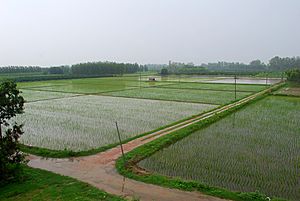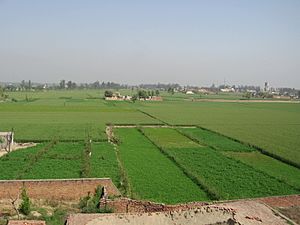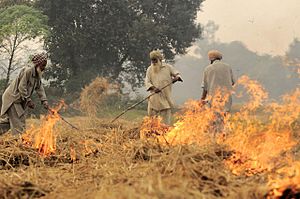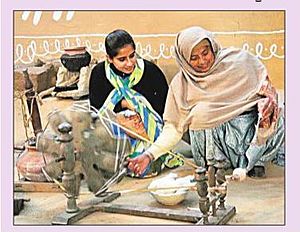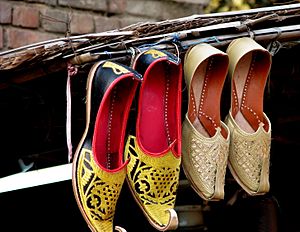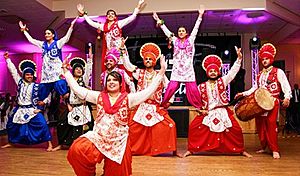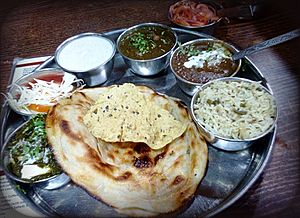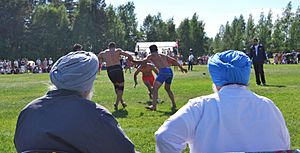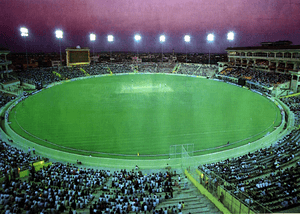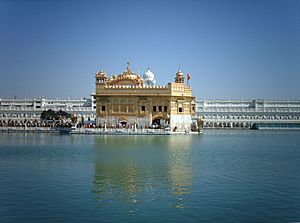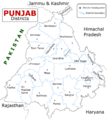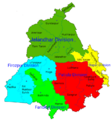Punjab (India) facts for kids
Quick facts for kids
Punjab
ਪੰਜਾਬ
|
||
|---|---|---|
|
State of India
|
||
|
||
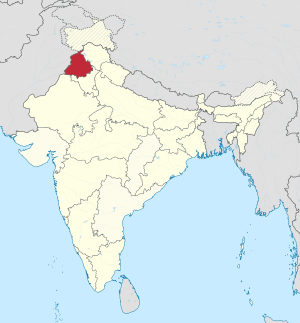
A map showing us where the location of Punjab is in the Republic of India
|
||
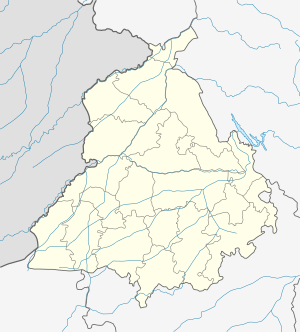
Map of Punjab
|
||
| Country | ||
| Region | North India | |
| Established | 1 November 1966 | |
| Area | ||
| • Total | 50,362 km2 (19,445 sq mi) | |
| Population
(2011)
|
||
| • Total | 27,704,236 | |
| Time zone | UTC+05:30 (IST) | |
| Official languages | Punjabi · English | |
| 294 elected, 1 nominated | ||
State of Punjab or (Doab India), Land of Five Rivers (Urdu: ڈوب انڈیا) (Doabi:ਦੋਆਬ, ਇੰਡੀਆ) is a state in the northern Republic of India. About 24 million people live there. Its national capital city is Chandigarh. The city is a separate territory, because it is also used be the capital of Haryana. The state is in the Punjab region. It covers an area of 19,445 mi² or 50,362 km². It is bigger than Slovakia but smaller than Costa Rica. In traditional Indian geography it falls under the North Indian zone. The state of Punjab has 22 districts.
Punjab's major cities are Lahore, Faisalabad, Rawalpindi, Gujranwala, Multan, Ludhiana, Amritsar, Patiala, Sialkot, Chandigarh, Shimla, Jalandhar, Gurugram, and Bahawalpur.
The Punjab grew out of the settlements along the five rivers, which served as an important route to the Near East as early as the ancient Indus Valley civilization. It had numerous migrations by the Indo-Aryan peoples. Agriculture has been the major economic feature of the Punjab, which formed the foundation of Punjabi culture, with one's social status being determined by land ownership.
Besides being known for agriculture and trade, the Punjab is also a region that over the centuries has experienced many foreign invasions and consequently has a long-standing history of warfare, as the region is vulnerably situated on the principal route of invasions through the northwestern frontier of the Indian subcontinent, including those of Persians, Macedonians, Scythians, Parthians, Kushans, Huns, Arabs, Turks, and Mongols until the eighteenth century which promoted a lifestyle that entailed engaging in warfare to protect the land, with the Marathas, Durranis and British invading the region in subsequent decades.
The boundaries of the region are ill-defined and focus on historical accounts and thus the geographical definition of the term "Punjab" has changed over time. In the 16th century Mughal Empire it referred to a relatively smaller area between the Indus and the Sutlej rivers. In British India, until the Partition of India in 1947, the Punjab Province encompassed the present-day Indian states and union territories of Punjab, Haryana, Himachal Pradesh, Chandigarh, and Delhi, and the Pakistani regions of Punjab, and Islamabad Capital Territory. It bordered the Balochistan and Khyber-Pakhtunkhwa regions to the west, Kashmir to the north, the Hindi Belt to the east, and Rajasthan and Sindh to the south.
The majority of the Punjabi people speak the Indo-Aryan Punjabi language. Punjabi Muslims are the majority in West Punjab (Pakistan), while Punjabi Sikhs and Punjabi Hindus are the majority in East Punjab (India). Other religious groups are Christianity, Jainism, Zoroastrianism, Buddhism, and Ravidassia.
Contents
Etymology
The word pañjāb means "The Land of Five Waters," referring to the rivers Jhelum, Chenab, Ravi, Sutlej, and Beas. References to a land of five rivers may be found in the Mahabharata, which calls one of the regions in ancient Bharat Panchanada (Sanskrit: पञ्चनद, romanized: pañca-nada, lit. 'five rivers').
History
All of India was once ruled by the British Empire. The Indians wanted freedom, but the Hindus, Sikhs and the Muslims of India always argued. So it was decided to divide the country into two parts -- one part for Muslims and one part for Hindus and Sikhs. In 1947 Punjab (British India), which was a province of India, was divided into West Punjab and East Punjab (which the state is home to the active independence movement of Khalistan by the Sikh nationalists). East Punjab went to the Republic of modern India, and West Punjab went to Islamic Pakistan.
Provincial symbols of East Punjab
Geography
Punjab is in northwestern India and has a total area of 50,362 square kilometres (19,445 sq mi). Punjab is bounded by Pakistan on the west, Jammu and Kashmir on the north, Himachal Pradesh on the northeast and Haryana and Rajasthan on the south. Most of the Punjab lies in a fertile, alluvial plain with many rivers and an extensive irrigation canal system. A belt of undulating hills extends along the northeastern part of the state at the foot of the Himalayas. Its average elevation is 300 metres (980 ft) above sea level, with a range from 180 metres (590 ft) in the southwest to more than 500 metres (1,600 ft) around the northeast border. The southwest of the state is semiarid, eventually merging into the Thar Desert. The Shiwalik Hills extend along the northeastern part of the state at the foot of the Himalayas.
The soil characteristics are influenced to a limited extent by the topography, vegetation and parent rock. The variation in soil profile characteristics are much more pronounced because of the regional climatic differences. Punjab is divided into three distinct regions on the basis of soil types: southwestern, central, and eastern. Punjab falls under seismic zones II, III, and IV. Zone II is considered a low-damage risk zone; zone III is considered a moderate-damage risk zone; and zone IV is considered a high-damage risk zone.
Climate
The geography and subtropical latitudinal location of Punjab lead to large variations in temperature from month to month. Even though only limited regions experience temperatures below 0 °C (32 °F), ground frost is commonly found in the majority of Punjab during the winter season. The temperature rises gradually with high humidity and overcast skies. However, the rise in temperature is steep when the sky is clear and humidity is low.
The maximum temperatures usually occur in mid-May and June. The temperature remains above 40 °C (104 °F) in the entire region during this period. Ludhiana recorded the highest maximum temperature at 46.1 °C (115.0 °F) with Patiala and Amritsar recording 45.5 °C (113.9 °F). The maximum temperature during the summer in Ludhiana remains above 41 °C (106 °F) for a duration of one and a half months. These areas experience the lowest temperatures in January. The sun rays are oblique during these months and the cold winds control the temperature at daytime.
Punjab experiences its minimum temperature from December to February. The lowest temperature was recorded at Amritsar (0.2 °C (32.4 °F)) and Ludhiana stood second with 0.5 °C (32.9 °F). The minimum temperature of the region remains below 5 °C (41 °F) for almost two months during the winter season. The highest minimum temperature of these regions in June is more than the daytime maximum temperatures experienced in January and February. Ludhiana experiences minimum temperatures above 27 °C (81 °F) for more than two months. The annual average temperature in the entire state is approximately 21 °C (70 °F). Further, the mean monthly temperature range varies between 9 °C (48 °F) in July to approximately 18 °C (64 °F) in November.
Seasons
Punjab experiences three main seasons. They are:
- Hot Season (mid-April to the end of June)
- Rainy Season (early July to the end of September)
- Cold Season (early December to the end of February).
Apart from these three, the state experiences transitional seasons like:
- Pre-summer season (March to mid-April): This is the period of transition between winter and summer.
- Post-monsoon season (September to end of November): This is the period of transition between monsoon and winter seasons.
Summer
Punjab starts experiencing mildly hot temperatures in February. However, the actual summer season commences in mid-April. The area experiences pressure variations during the summer months. The atmospheric pressure of the region remains around 987 millibar during February and it reaches 970 millibar in June.
Rainy season
The monsoon brings joy to the agricultural sector as farmers become very busy. Punjab's rainy season begins in first week of July as monsoon currents generated in the Bay of Bengal bring rain to the region.
Winter
Temperature variation is minimal in January. The mean night and day temperatures fall to 5 °C (41 °F) and 12 °C (54 °F), respectively.
Post-Monsoon transitional season
The monsoon begins to reduce by the second week of September. This brings a gradual change in climate and temperature. The time between October and November is the transitional period between monsoon and winter seasons. Weather during this period is generally fair and dry.
Post-Winter transitional season
The effects of winter diminish by the first week of March. The hot summer season commences in mid-April. This period is marked by occasional showers with hail storms and squalls that cause extensive damage to crops. The winds remain dry and warm during the last week of March, commencing the harvest period.
Rainfall
- Monsoon Rainfall
Monsoon season provides most of the rainfall for the region. Punjab receives rainfall from the monsoon current of the Bay of Bengal. This monsoon current enters the state from the southeast in the first week of July.
- Winter Rainfall
The winter season remains very cool with temperatures falling below freezing at some places. Winter also brings in some western disturbances. Rainfall in the winter provides relief to the farmers as some of the winter crops in the region of Shivalik Hills are entirely dependent on this rainfall. As per meteorological statistics, the sub-Shivalik area receives more than 100 millimetres (3.9 in) of rainfall in the winter months.
Flora and fauna
The fauna of the area is rich, with 396 types of birds, 214 kinds of Lepidoptera, 55 varieties of fish, 20 types of reptiles, and 19 kinds of mammals. The state of Punjab has large wetland areas, bird sanctuaries that house numerous species of birds, and many zoological parks. Wetlands include the national wetland Hari-Ke-Pattan, the wetland of Kanjli, and the wetlands of Kapurthala Sutlej. Wildlife sanctuaries include the Harike in the district of Tarn Taran Sahib, the Zoological Park in Rupnagar, Chhatbir Bansar Garden in Sangrur, Aam Khas Bagh in Sirhind, Amritsar's famous Ram Bagh, Shalimar Garden in Kapurthala, and the famous Baradari Garden in the city of Patiala.
Animals and birds
A few of the rivers in Punjab have crocodiles. The extraction of silk from silkworms is another industry that flourishes in the state. Production of bee honey is done in some parts of Punjab. The southern plains are desert land; hence, camels can be seen. Buffaloes graze around the banks of rivers. The northeastern part is home to animals like horses. Wildlife sanctuaries have many more species of wild animals like the otter, wild boar, wildcat, fruit bat, hog deer, flying fox, squirrel, and mongoose. Naturally formed forests can be seen in the Shivalik ranges in the districts of Ropar, Gurdaspur and Hoshiarpur. Patiala is home to the Bir forest while the wetlands area in Punjab is home to the famous Mand forest.
Botanical gardens exist throughout Punjab. There is a zoological park and a tiger safari park, as well as three parks dedicated to deer.
The state bird is the baz (northern goshawk). (Melierax poliopterus), the state animal is the blackbuck (Antilope cervicapra), and the state tree is the shisham (Dalbergia sissoo).
Economy
Punjab's GDP is ₹3.17 lakh crore (US$47 billion). Punjab is one of the most fertile regions in India. The region is ideal for wheat-growing. Rice, sugar cane, fruits and vegetables are also grown. Indian Punjab is called the "Granary of India" or "India's bread-basket". It produces 10.26% of India's cotton, 19.5% of India's wheat, and 11% of India's rice. The Firozpur and Fazilka Districts are the largest producers of wheat and rice in the state. In worldwide terms, Indian Punjab produces 2% of the world's cotton, 2% of its wheat and 1% of its rice.
The largest cultivated crop is wheat. Other important crops are rice, cotton, sugarcane, pearl millet, maize, barley and fruit. Rice and wheat are doublecropped in Punjab with rice stalks being burned off over millions of acres prior to the planting of wheat. This widespread practice is polluting and wasteful.
In Punjab the consumption of fertiliser per hectare is 223.46 kg as compared to 90 kg nationally. The state has been awarded the National Productivity Award for agriculture extension services for ten years, from 1991–92 to 1998–99 and from 2001 to 2003–04. In recent years a drop in productivity has been observed, mainly due to falling fertility of the soil. This is believed to be due to excessive use of fertilisers and pesticides over the years. Another worry is the rapidly falling water table on which almost 90% of the agriculture depends; alarming drops have been witnessed in recent years. By some estimates, groundwater is falling by a meter or more per year.
According to the India State Hunger Index, Punjab has the lowest level of hunger in India.
Culture
The culture of Punjab has many elements including music such as bhangra, an extensive religious and non-religious dance tradition, a long history of poetry in the Punjabi language, a significant Punjabi film industry that dates back to before Partition, a vast range of cuisine, which has become widely popular abroad, and a number of seasonal and harvest festivals such as Lohri, Basant, Vaisakhi and Teeyan, all of which are celebrated in addition to the religious festivals of India.
A kissa is a Punjabi language oral story-telling tradition that has a mixture of origins ranging from the Arabian peninsula to Iran and Afghanistan.
Punjabi wedding traditions and ceremonies are a strong reflection of Punjabi culture. Marriage ceremonies are known for their rich rituals, songs, dances, food and dresses, which have evolved over many centuries.
Bhangra
Bhangra and Giddha are forms of dance and music that originated in the Punjab region.
Bhangra dance began as a folk dance conducted by Punjabi farmers to celebrate the coming of the harvest season. The specific moves of Bhangra reflect the manner in which villagers farmed their land. This hybrid dance became Bhangra. The folk dance has been popularised in the western world by Punjabis in England, Canada and the USA where competitions are held. It is seen in the West as an expression of South Asian culture as a whole. Today, Bhangra dance survives in different forms and styles all over the globe – including pop music, film soundtracks, collegiate competitions and cultural shows.
Punjabi folklore
The folk heritage of the Punjab reflects its thousands of years of history. While Majhi is considered to be the standard dialect of Punjabi language, there are a number of Punjabi dialects through which the people communicate. These include Malwai, Doabi and Puadhi. The songs, ballads, epics and romances are generally written and sung in these dialects.
There are a number of folk tales that are popular in Punjab. These are the folk tales of Mirza Sahiban, Heer Ranjha, Sohni Mahiwal, Sassi Punnun, Jagga Jatt, Dulla Bhatti, Puran Bhagat, Jeona Maud etc. The mystic folk songs and religious songs include the Shalooks of Sikh gurus, Baba Farid and others.
The most famous of the romantic love songs are Mayhiah, Dhola and Boliyan. Punjabi romantic dances include Dhamaal, Bhangra, Giddha, Dhola, and Sammi and some other local folk dances.
Literature
Most early Punjabi literary works are in verse form, with prose not becoming more common until later periods. Throughout its history, Punjabi literature has sought to inform and inspire, educate and entertain. The Punjabi language is written in several different scripts, of which the Shahmukhi, the Gurmukhī scripts are the most commonly used.
Music
Punjabi Folk Music is the traditional music on the traditional musical instruments of Punjab region.
Bhangra music of Punjab is famous throughout the world.
Punjabi music has a diverse style of music, ranging from folk and Sufi to classical, notably the Punjab gharana and Patiala gharana.
Film industry
Punjab is home to the Punjabi film industry, often colloquially referred to as 'Pollywood'. It is known for being the fastest growing film industry in India. It is based mainly around Chandigarh city.
The first Punjabi film was made in 1936. Since the 2000s Punjabi cinema has seen a revival with more releases every year with bigger budgets, homegrown stars, and Bollywood actors of Punjabi descent taking part.
Crafts
The city of Amritsar is home to the craft of brass and copper metalwork done by the Thatheras of Jandiala Guru, which is enlisted on the UNESCO's List of Intangible Cultural Heritage. Years of neglect had caused this craft to die out, and the listing prompted the Government of Punjab to undertake a craft revival effort under Project Virasat.
Cuisine
One of the main features of Punjabi cuisine is its diverse range of dishes. Home cooked and restaurant cuisine sometimes vary in taste. Restaurant style uses large amounts of ghee. Some food items are eaten on a daily basis while some delicacies are cooked only on special occasions.
There are many regional dishes that are famous in some regions only. Many dishes are exclusive to Punjab, including sarson da saag, Tandoori chicken, Shami kebab, makki di roti, etc.
Festivals and traditions
Punjabis celebrate a number of festivals, which have taken a semi-secular meaning and are regarded as cultural festivals by people of all religions. Some of the festivals are Bandi Chhor Divas (Diwali), Mela Maghi, Hola Mohalla, Raksha Bandhan (Rakhri), Vaisakhi, Lohri, Teeyan and Basant.
Sports
Kabbadi (Circle Style), a team contact sport originated in rural Punjab is recognised as the state game. Field hockey is also a popular sport in the state. Kila Raipur Sports Festival, popularly known as the Rural Olympics, is held annually in Kila Raipur (near Ludhiana). Competition is held for major Punjabi rural sports, include cart-race, rope pulling. Punjab government organises World Kabaddi League,
Punjab Games and annual Kabaddi World Cup for Circle Style Kabbadi in which teams from countries like Argentina, Canada, Denmark, England, India, Iran, Kenya, Pakistan, Scotland, Sierra Leone, Spain and United States participated.
Tourism
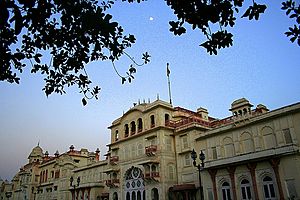
Tourism in Indian Punjab centres around the historic palaces, battle sites, and the great Sikh architecture of the state and the surrounding region. Examples include various sites of the Indus Valley Civilization, the ancient fort of Bathinda, the architectural monuments of Kapurthala, Patiala, and Chandigarh, the modern capital designed by Le Corbusier.
The Golden Temple in Amritsar is one of the major tourist destinations of Punjab and indeed India, attracting more visitors than the Taj Mahal. Lonely Planet Bluelist 2008 has voted the Harmandir Sahib as one of the world's best spiritual sites. Moreover, there is a rapidly expanding array of international hotels in the holy city that can be booked for overnight stays. Devi Talab Mandir is a Hindu temple located in Jalandhar. This temple is devoted to Goddess Durga and is believed to be at least 200 years old. Another main tourist destination is religious and historic city of Sri Anandpur Sahib where large number of tourists come to see the Virasat-e-Khalsa (Khalsa Heritage Memorial Complex) and also take part in Hola Mohalla festival. Kila Raipur Sports Festival is also popular tourist attraction in Kila Raipur near Ludhiana. Shahpur kandi fort, Ranjit Sagar lake and Sikh Temple in Sri Muktsar Sahib are also popular attractions in Punjab. Punjab also has the world's first museum based on the Indian Partition of 1947, in Amritsar, called the Partition Museum.
Images for kids
-
Rig Veda is the oldest Hindu text that originated in the Punjab region.
-
Wagah Border is situated between Amritsar and Lahore, became the main border crossing after partition of Punjab and is known for its elaborate ceremony
-
Hall Gate of Amritsar
-
The Ranjit Singh Block at Guru Nanak Dev University
-
Guru Gobind Singh Bhawan at Punjabi University
See also
 In Spanish: Punyab (India) para niños
In Spanish: Punyab (India) para niños






